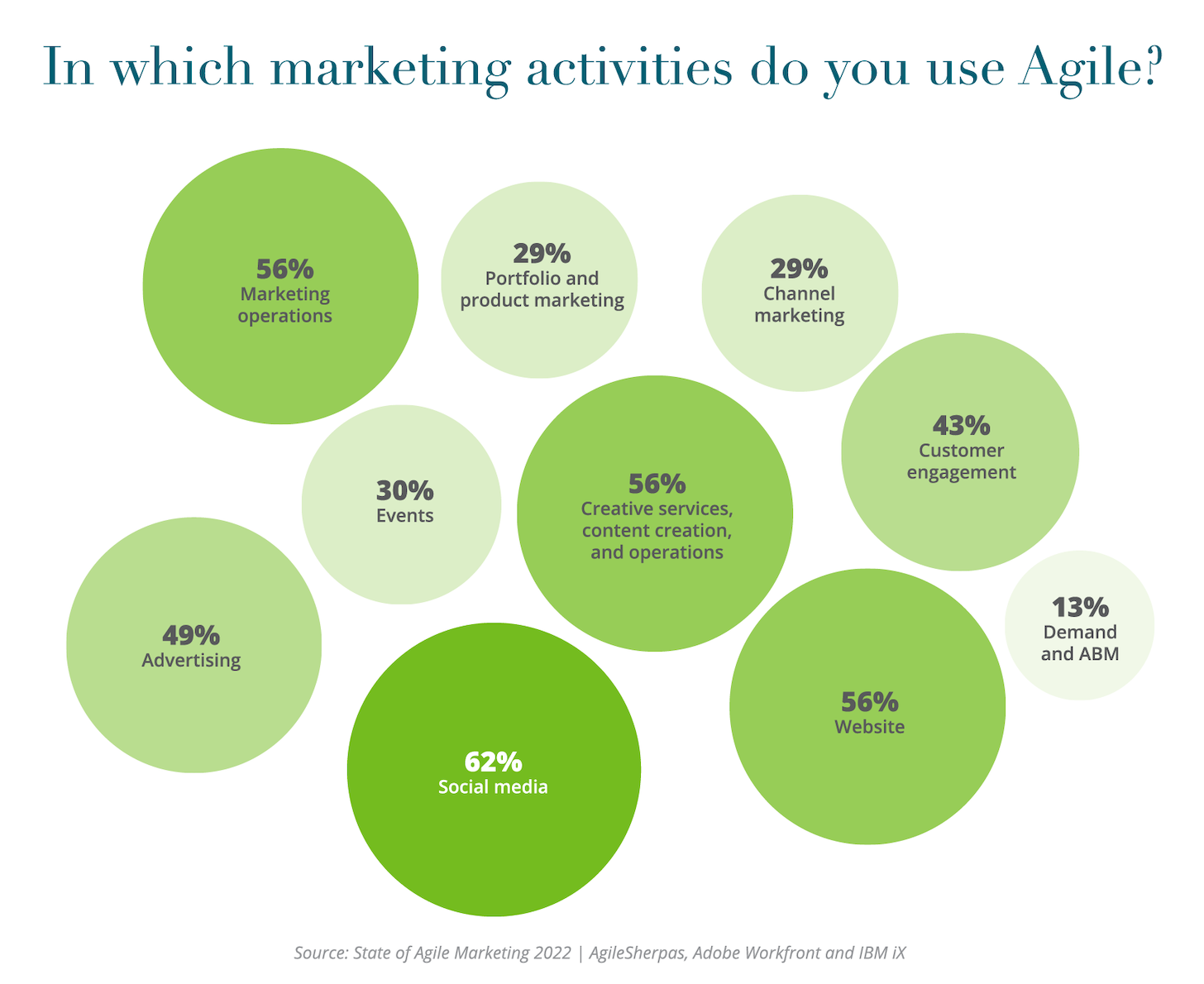
Catching up on my backlog of data and topics from before #MartechDay earlier this month — which featured the 2022 marketing technology landscape and the 2022 Stackies — the top of my list is the latest State of Agile Marketing report from AgileSherpas.
As always, this is a terrific, comprehensive report on how and why agile methodologies are being used in marketing. You can see from the chart above that agile has found its way into a wide variety of marketing activities: marketing operations, creative services, website operations, social media, advertising, etc.
It’s even being applied (30%) in events marketing, which has long been the go-to example for skeptics: “Oh, agile could never work for events.” (To be fair, in a virtual/hybrid event world, the pacing and adaptability of events marketing has increased significantly.)
But unlike last year, when 51% of participants reported using agile marketing, this time only 43% did. That’s close to the 42% from 2020. Is agile marketing backsliding?
Of course, the most obvious disclaimer is the survey sample. Even with 513 marketers participating in this latest survey, it’s still a very small subset of the diverse marketing universe and no doubt subject to the ebbs and flows of selection bias.
But still. After nearly 15 years of advocacy for agile marketing, the momentum of this movement seems… stalled?
Agile marketing principles, practices & labels
The principles of agile marketing, however, seem to be universally accepted as gospel truth these days. I can’t think of a single marketer I’ve met in the past several years who hasn’t embraced the values of adaptability, learning from experimentation, iterative improvement, cross-team collaboration, greater visibility into work-in-flight, team empowerment, etc.
Marketing has become an agile profession. Full stop.
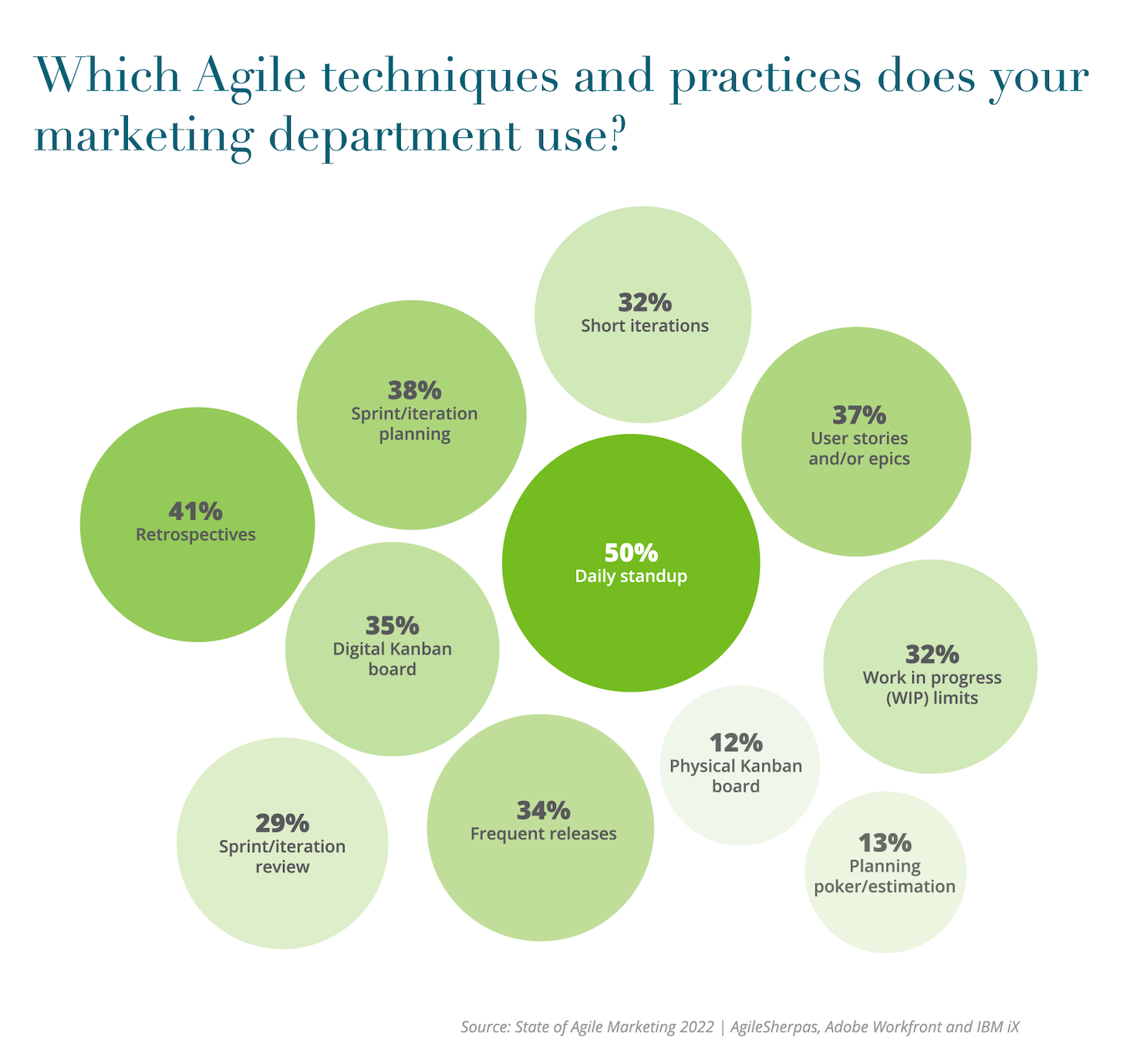
Classic agile practices — such as sprints, daily standups, kanban boards, etc. — also seem to have proliferated widely. Although in many cases, they’ve morphed from their original form. We’ll come back to that in a minute, as I think it’s the twist of post-agile.
But the labels? Not so much. I very rarely hear the terms sprint, standup, or kanban in marketing discussions. Even “agile marketing” as a term arises less frequently than it seemed a couple of years ago.
Agile marketing vs. agile development trends
A couple of charts from Google Trends help illustrate what’s happening here. First, let’s just look at the growth of the search term “agile marketing”:
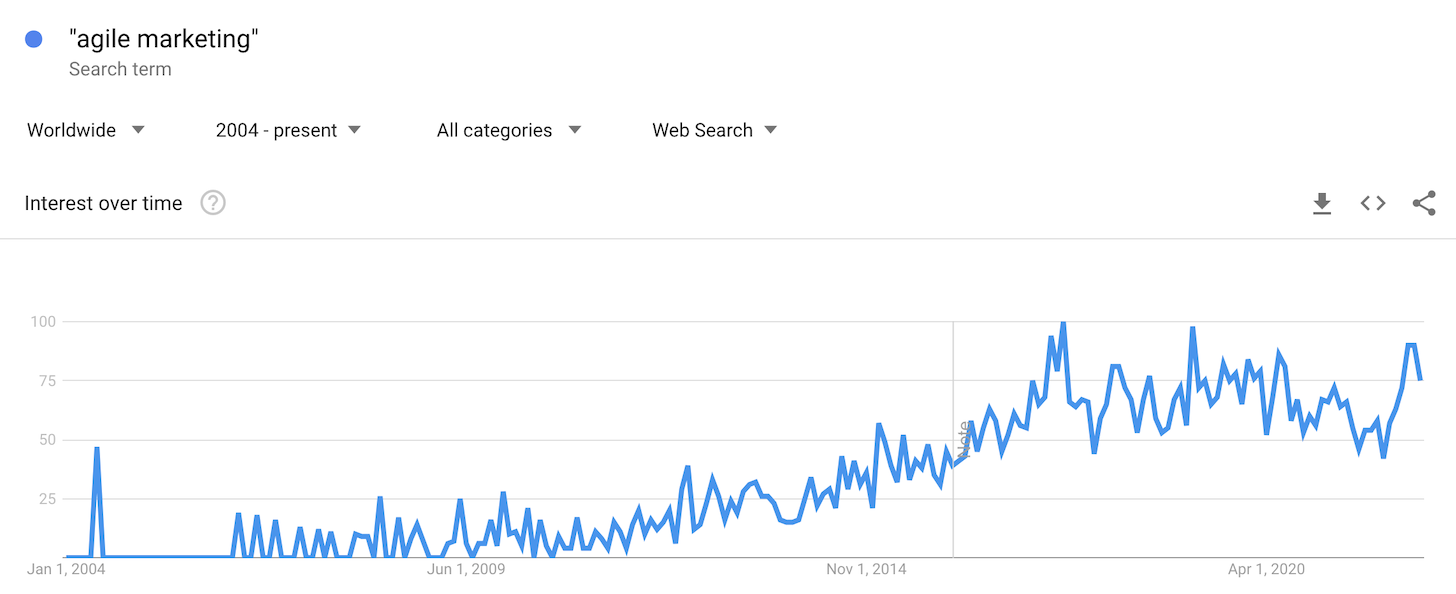
The chart shows relative search volume for this term over the past 18 years. You can see that it peaked around 2017. (A year after the release of Hacking Marketing. Coincidence?) Since then, it’s had fluctations up and down. But it largely hit a ceiling.
To get a better sense of how much absolute search volume there is for agile marketing, you need to compare it against another trend. So let’s compare it against its progenitor, “agile development”:

Two things pop right out. First, agile marketing has achieved only a tiny fraction of the mindshare that agile development ever did. Second, interest in agile development has steadily declined since 2010. It’s around 1/4 of the volume it was at its peak.
What happened in 2010? The rise of DevOps.
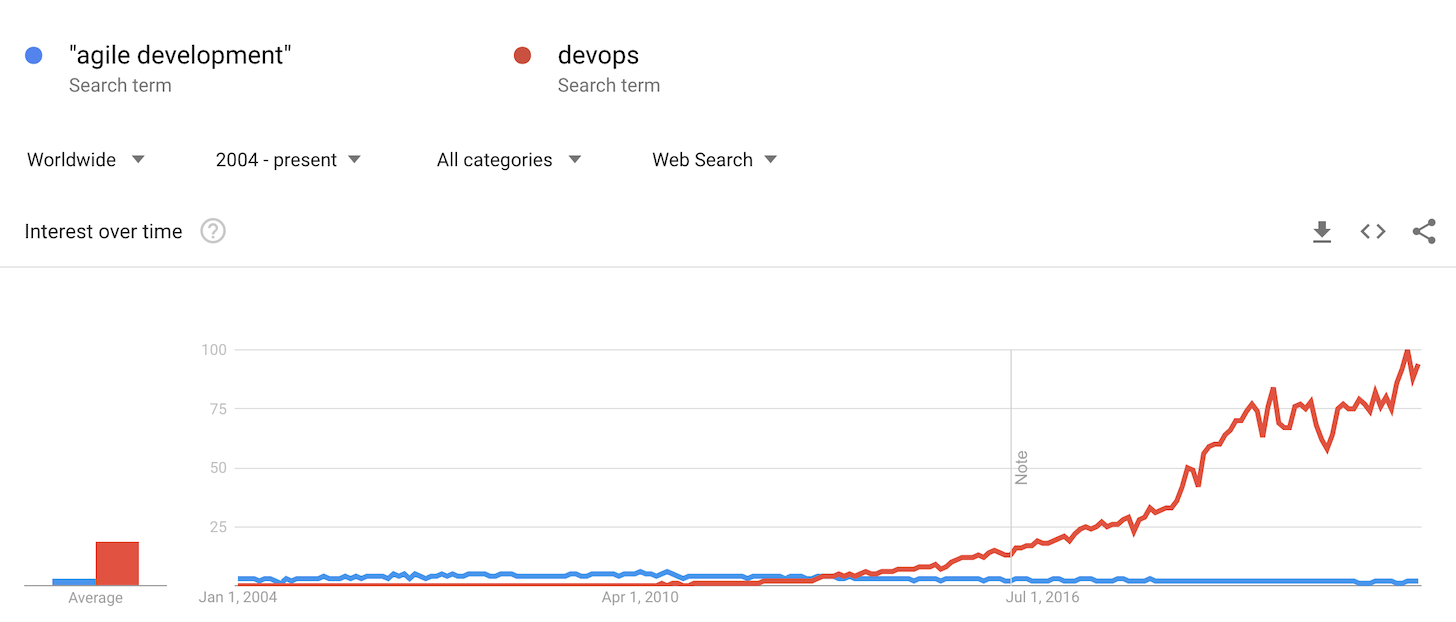
Indeed, DevOps became the giant that stood on the shoulders of agile development. Its popularity has dwarfed agile development, even from its heyday. And compared to those two, agile marketing would barely even register on the scale.
But it’s important to note that DevOps arose from Agile. To quote its Wikipedia article:
“Agile development teams… couldn’t ‘satisfy the customer through early and continuous delivery of valuable software’ unless they subsumed the operations / infrastructure responsibilities associated with their applications, many of which they automated.”
DevOps “aims to shorten the systems development lifecycle and provide continuous delivery with high software quality.” What is continuous integration/continuous deployment (CI/CD) if not the ultimate mechanism for delivering iterative software development?
As Forrest Gump might say, “Agile is as agile does.”
The plummeting costs of “shipping” in the cloud
To be clear, DevOps is not an agile management methodology. It’s not even an “ops” team (in most cases) like other ops functions, such as marketing ops. Rather, it’s a set of practices, processes, and technology that developers use to ship software quickly, iteratively, and safely. It leverages a ton of automation and instrumentation.
DevOps optimizes building and deploying software, but deciding what to build and when still needs to happen at a level above that. In theory, agile development methodologies such as Scrum can provide the framework for those decisions. But most dev teams I know don’t explicitly use those methodologies anymore. Most have invented their own process, pulling concepts from agile methodologies and adapting them and leveraging dev project management tools such as Jira.
My take: DevOps — and more broadly, the cloud — has dramatically reduced the costs of iteratively developing software. Back in the days when agile methodologies such as Scrum were created, the costs and complexities of shipping were much higher. The rigid structure of Scrum was an effective and necessary way to manage that. Today in a good DevOps environment? Not as necessary?
That’s not to say that strategy, planning, roadmaps, prioritization, and all the coordination and collaboration required around them aren’t necessary. They’re as crucial to success as ever. But the rigidity of Scrum in translating that into iterative release cycles? Not as necessary?
(Let the flames from ardent agile advocates commence.)
Is there a DevOps equivalent in marketing?
Marketing ops is a different kind of creature that DevOps. For one, it is a role/team within the marketing org, rather than a practice/process that all marketers use.
Yet there is some shared DNA. In many ways, marketing ops teams function as a DevOps-like enabler for marketers to be able to “ship” marketing quickly, iteratively, and safely. Marketing ops manages the tech stack and processes to enable that — through a ton of automation and instrumentation.
Yet with the rise of more and more no-code capabilities across martech, marketing ops is also empowering marketers with more and more self-service capabilities. Just as software deployment ops got “shifted left” (i.e., moved upstream) into more developers’ hands with DevOps, more capabilities to execute marketing — both internal and external marketing “deployments” — are being shifted into the hands of general marketers.
I don’t know that there’s a name for this phenomenon. It’s a kind of democratization of certain facets of marketing ops. (Ideally under the guidance, governance, and guardrails of the expert marketing ops team.) But it is increasingly analogous to DevOps. More people can ship more marketing, quickly, easily, and safely.
Just as with software, strategy, planning, roadmaps, prioritization, team coordination and collaboration are essential to effectively harness this distributed power of creation. But just as similarly, the costs in deploying most kinds of marketing have dropped dramatically over the past decade. This has created more slack in the marketing production process, which has made rigid agile marketing methodologies… not as necessary?
(Honestly posed as a question, not a declaration.)
New agile practices: Pods, DARCIs, Slack, “Work OS”
Speaking of slack, or, um, Slack, the past 10 years has also brought an explosion of innovation in work communications and collaboration products. For instance, Slack and Microsoft Teams have become ubiquitous — along with a whole ecosystem of apps that extend and integrate with them. A new generation of work management platforms, such as Asana, ClickUp, Monday.com, and (for marketers) Workfront, provide greater structure and visibility into complex, fast-moving priorities, projects, and workflows.
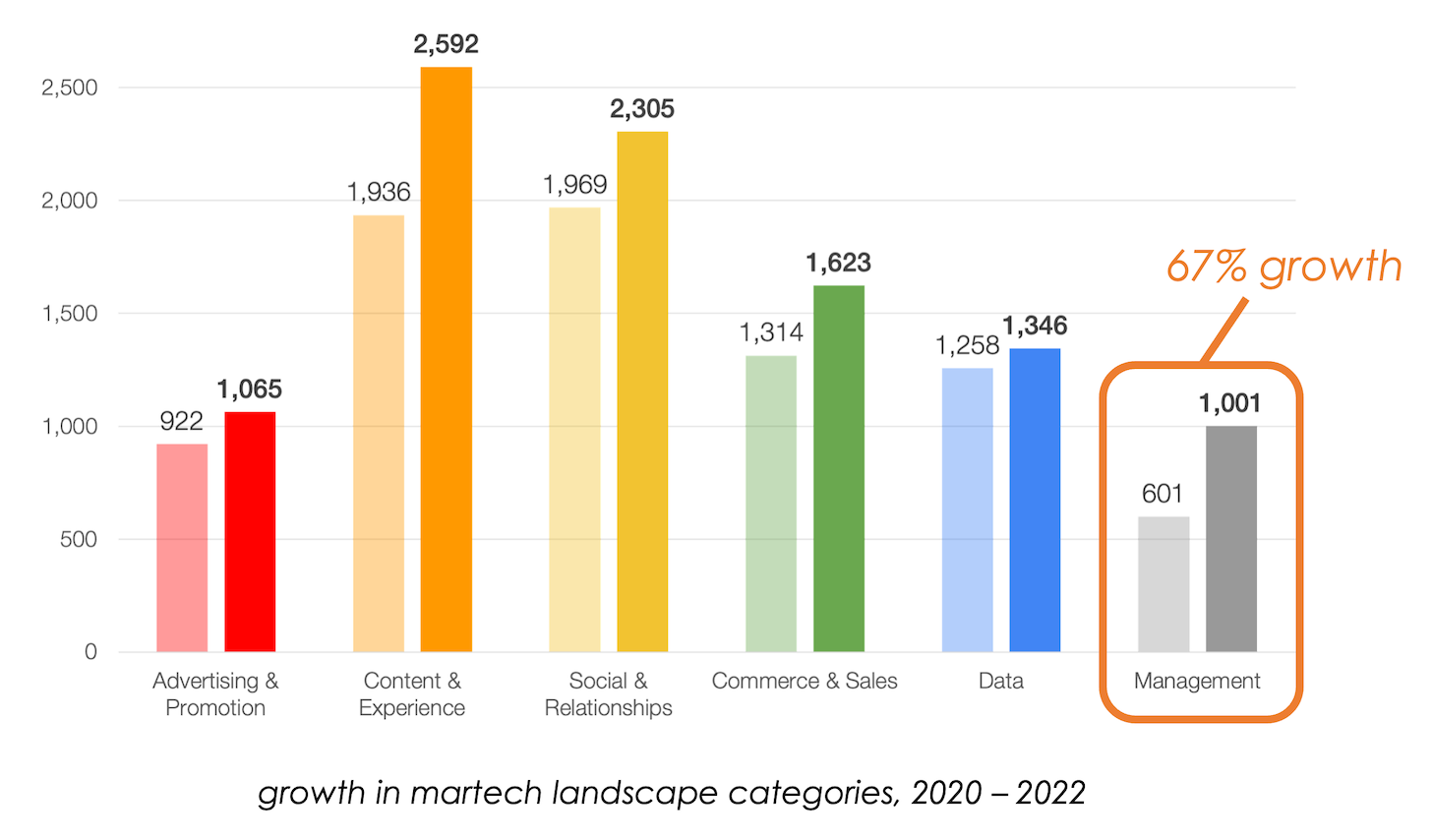
Indeed, the Management category of the martech landscape had the largest percentage growth from 2020 to 2022.
These tools have had a significant impact on how work gets done. Many of them embed or enable agile (lowercase “a”) practices. Almost none of them use the terminology of agile marketing methodologies. But the essence of agile is there: transparency, prioritization, accountability, work-in-progress management, identification of blockers and bottlenecks.
Meanwhile, I’d say that Slack and Teams — accelerated by the Great Migration to Remote Work — have effectively killed replaced the daily stand-up for most teams.
But it’s not that the underlying principle of stand-ups has gone away. On the contrary, these team communications platforms generally make it easier for teams to stay connected throughout the day in a relatively low-impact manner. Issues that arise can be addressed faster than waiting for the next stand-up in a fixed time window that increasingly fails to align with the schedules of distributed team members.
Hey, I’m still a huge fan of in-person collaboration, and I agree something is lost without it. But other things are gained. And for better and worse, remote and hybrid teams are the new normal. In this brave new world, Slack and Teams are a better fit than daily stand-ups for many.
And it’s not just technology. Management methods that I think of as “point solutions” for specific needs — in contrast to a whole suite of practices, as with formal agile marketing — have been popularized for better cross-functional collaboration (e.g., pods outside the context of formal agile) and multi-party decision-making (e.g., DARCI models).
The net effect? Marketing teams are becoming more and more agile.
They just don’t necessarily think of their practices as formal “agile marketing.”
From agile marketing to… marketing?
Whatever happened to digital marketing? It became marketing.
Not because marketing became less digital. Quite the opposite. Digital became so embedded in everything marketers were doing that the label of the profession reverted to the mean: marketing. I’d call that a victory for the digital marketing movement, not defeat.
Similarly, is agile marketing simply becoming… marketing?
Maybe “agile marketing” will restart its growth as an explicit movement. Or maybe it will be replaced by some newly named methodology that is closer to what DevOps has become in the software development profession. Or maybe is just becomes implicit in how modern marketing teams run.
Agile is as agile does.
Regardless, I still believe there is a huge opportunity for teaching marketing teams how to best harness all these platforms, practices, and processes. There’s never been more demand for helping marketing teams achieve peak performance through good training, enablement, consulting, and advisory services in today’s environment.
Does the name we call it really matter?


